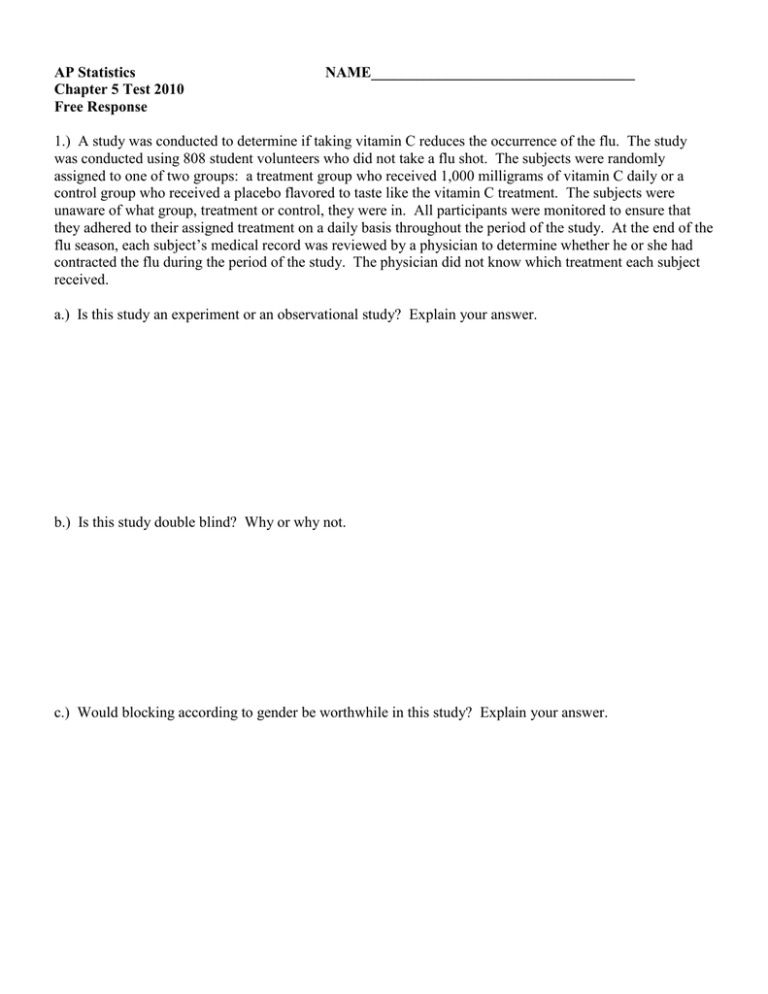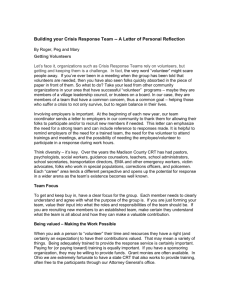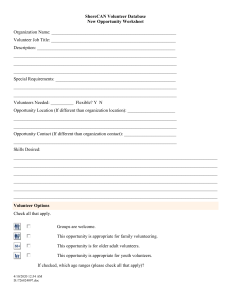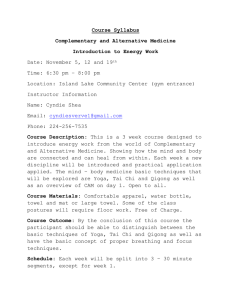Chapter 5 test free response-2010
advertisement

AP Statistics Chapter 5 Test 2010 Free Response NAME___________________________________ 1.) A study was conducted to determine if taking vitamin C reduces the occurrence of the flu. The study was conducted using 808 student volunteers who did not take a flu shot. The subjects were randomly assigned to one of two groups: a treatment group who received 1,000 milligrams of vitamin C daily or a control group who received a placebo flavored to taste like the vitamin C treatment. The subjects were unaware of what group, treatment or control, they were in. All participants were monitored to ensure that they adhered to their assigned treatment on a daily basis throughout the period of the study. At the end of the flu season, each subject’s medical record was reviewed by a physician to determine whether he or she had contracted the flu during the period of the study. The physician did not know which treatment each subject received. a.) Is this study an experiment or an observational study? Explain your answer. b.) Is this study double blind? Why or why not. c.) Would blocking according to gender be worthwhile in this study? Explain your answer. 2) In response to nutrition concerns raised last year about food served in school cafeterias, the Smallville School District entered into a one-year contract with the Healthy Alternative Meals (HAM) Company. Under this contract, the company plans and prepares meals for 2,500 elementary, middle, and high school students, with a focus on good nutrition. The school administration would like to survey the students in the district to estimate the proportion of students who are satisfied with the food under this contract. Two sampling plans for selecting the students to be surveyed are under consideration by the administration. One plan is to take a simple random sample of students in the district and then survey those students. The other plan is to take a stratified random sample of students in the district and then survey those students. (a) Describe a simple random sampling procedure that the administrators could use to select 200 students from the 2,500 students in the district. (b) If a stratified random sampling procedure is used, give one example of an effective variable on which to stratify in this survey. Explain your reasoning. . 3.) Because of concerns about employee stress, a large company is conducting a study to compare two programs (tai chi or yoga) that may help employees reduce their stress levels. Tai chi is a 1,200 year-old practice, originating in China, that consists of slow, fluid movements. Yoga is a practice, originating in India, that consists of breathing exercises and movements designed to stretch and relax muscles. The company has assembled a group of volunteer employees to participate in the study during the first half of their lunch hour each day for a 10 week period. Each volunteer will be assigned at random to one of the two programs. Volunteers will have their stress levels measured just before beginning the program and 10 weeks later at the completion of it. a.) A group of volunteers who work together in the same department ask to be assigned to the same program so that they can participate in that program together. Give an example of a problem that might arise if this is permitted. Explain to this volunteer group why random assignment to the two programs will address this problem. b.) Someone proposes that a control group be included in the design as well. The stress level would be measured for each volunteer assigned to the control group at the start of the study and again 10 weeks later. What additional information, if any, would this provide about the effectiveness of the two programs?





